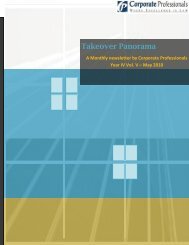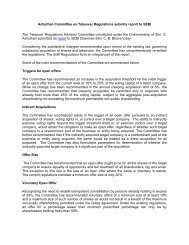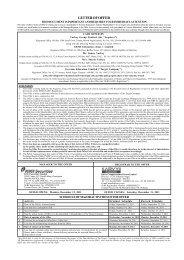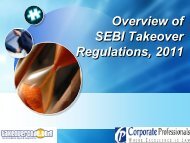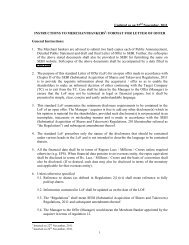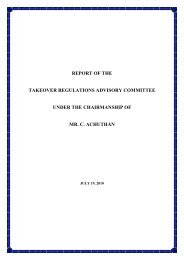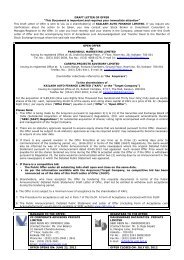1 2 3 4 TC = MB = RBI = SAT = DOD = PA = Reserve Bank of India ...
1 2 3 4 TC = MB = RBI = SAT = DOD = PA = Reserve Bank of India ...
1 2 3 4 TC = MB = RBI = SAT = DOD = PA = Reserve Bank of India ...
Create successful ePaper yourself
Turn your PDF publications into a flip-book with our unique Google optimized e-Paper software.
Ferreira MIDCeventual falls and moisture. In the cases where theequipment is wet or with excess <strong>of</strong> wax on the point <strong>of</strong>obstructing the mould or capsule receptor, the technicalassistance must be informed. In this case the patient mustbe advised by the ORL doctor, for such excess <strong>of</strong> wax, inthe external acoustic meatus, prevent the passage <strong>of</strong>amplified sound to the internal ear.Such guidance and advise are intended to enablethe individuals to find solution for their difficulties interferingand influencing from the acceptance <strong>of</strong> the hearing loss upto the compliance with rehabilitation guidance. Thisexplains the value <strong>of</strong> the researches that help in theacclimatization understanding. Considering the existence<strong>of</strong> a necessary period <strong>of</strong> sound amplification use to reestablishthe speaking abilities and evaluate the benefits obtainedwith amplification, there is the need for studies that followup the hearing aid new user auditory function developmentin order to verify how and when the sound acclimatizationoccurs, by taking into account the user’s abilities <strong>of</strong> speech,use benefit and satisfaction (13).This work compares the knowledge <strong>of</strong> old and newusers <strong>of</strong> hearing aid under fitting process to <strong>of</strong>fer a greaterknowledge on the aspects that mostly influence in thefitting process.METHODThis research consists <strong>of</strong> an observational, descriptive,transversal, contemporary and retrospective study. It wasapproved by the Ethics Committee in Research under thenumber 342/2007 on 03/03/2008This research’s population comprised adult and oldaged, new and old users <strong>of</strong> hearing aid from the city <strong>of</strong> PortoAlegre and the metropolitan region <strong>of</strong> Rio Grande do Sul.The sample was composed by 51 individuals <strong>of</strong>both sexes (24 women and 27 men) from 28 to 91 years<strong>of</strong> age divided into two groups: 28 old users and 23 newusers <strong>of</strong> hearing aid. The old users group contain 12 womenand 16 men and the new users group contain 12 womenand 11 men.To take part in this research we included allcustomers who signed the (<strong>TC</strong>LE) Free and ClearAuthorization Term, had acquired a hearing aid in a periodlonger than six months, and were considered as old usersand all customers who had acquired the hearing aid as fromthe date <strong>of</strong> this project approval in the Ethics Committeein Research, and were deemed to be the new users.This study exclusion criteria were: diagnosed diseaseor symptom that harmed the individual’s mental, intellectualand speaking abilities, prevented the performance <strong>of</strong> theinterview and those who purchased the hearing aid in aperiod lower than six months, for these couldn’t beconsidered neither as old nor as new users.This research was composed by the following steps:sample selection by the researcher taking into account theexclusion factors according to the individuals’ group (hearingaid old and new users); accomplishment by the researcher<strong>of</strong> individual interview with the sample’s participants;tabulation <strong>of</strong> data obtained in the interview, according tothe individuals’ group; quantitative and qualitative resultsreview, by meeting the abovementioned objectives .The abovementioned study steps were carried outin an auditory center in the city <strong>of</strong> Porto Alegre, thatallowed the research performance through the InstitutionalConsent Term.Both groups <strong>of</strong> old and new hearing aid usersresponded to a questionnaire prepared by this study’sauthors, with 25 closed questions applied by the AuditoryCenter technical responsible phonoaudiologist, in the samesequence.This questionnaire was prepared with focus on theinterviewed individuals identification data (age, sex,education, type and time <strong>of</strong> use <strong>of</strong> the hearing aid,technology, monoaural or binaural use) and the questionspursuant to general knowledge required for the fitting,cares, decision and external influence. The participantsshould answer if they had to use the hearing aid all day inthe first week, if there is the need for removing thebattery when it’s not in use, if they should know andhandle the several types <strong>of</strong> hearing aids before choosingthe one they were to buy or which they bought, if theyneed to care for the use in case <strong>of</strong> sweating or if they gotout in the rain, the hearing aid may remain in hot andmoist places, if there is need to remove the hearing aidto take shower, to search for technical assistance in case<strong>of</strong> fall, wet hearing aid or with excess <strong>of</strong> wax, if theyshould take care to prevent it from falling, if they thoughtit necessary to take advice with the ORL doctor in case <strong>of</strong>excess <strong>of</strong> wax in the MAE, if the mould or capsule couldbe lent to somebody else, what is the time for fitting theuser thinks to be necessary for the use <strong>of</strong> the hearing aid,if the customer feels ashamed to use the hearing aid inpublic, if the decision and initiative for use was <strong>of</strong> the veryuser, if he or she knows someone who uses hearing aid,if this person is satisfied, if it’s necessary to remake themould or the capsule every year, if upon purchasing thehearing aid the customer will need to return to theauditory center and if he or she considers important thepresence <strong>of</strong> a relative at the moment <strong>of</strong> receiving guidance386Intl. Arch. Otorhinolaryngol.,São Paulo, v.12, n.3, p. 384-392, 2008.



